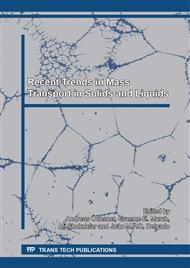p.1
p.12
p.29
p.35
p.39
p.48
p.55
p.60
Metallurgists’ Insights on Diffusion-Assisted Dissimilar-Joints of Light- and Heavy-Alloys
Abstract:
In metallurgy and materials engineering, a number of phase transformation in solids like precipitation, oxidation, creep, annealing, homogenization, etc. are brought about by the process of diffusion. Many industrial manufacturing processes utilize solid-state diffusion principle, to name a few: 1. Rotating or sliding parts of steel have a hard outside case for wear resistance and a tough inner core for fracture resistance by gas carburizing procedure; 2. Integrated circuits were produced by diffusing impurity into silicon wafers; and 3. Joints between similar and dissimilar metals, alloys, and non-metals, were made using diffusion bonding (DB) technique. Day by day, the science of solid-state diffusion phenomenon is spreading inevitably into new areas of engineering and technology. Diffusion-Assisted-Joints (DAJs) meet the requirements for most critical structures in terms of strength, toughness, tightness, and resistance to heat and corrosion. DAJs can be made out of 730 pairs of dissimilar metals. Hence, DB is considered as an engineering marvel among all the physical welding metallurgists. Herein, experiments were performed to exactly map the quantum influence of the bonding temperature variation on the dissimilar joints of a popular light alloy, Ti-6Al-4V (TiA), and a heavily used heavy alloy, stainless steel (SS), using diffusion mechanism in high-vacuum environment. Cu foil (~200 μm) was used as an interlayer. Necessary characterization tools for metallurgical investigations were used to understand the extent of diffusion along the TiA/Cu and Cu/SS interfaces, room-temperature mechanical properties, fracture morphologies, and fracture path of the TiA/Cu/SS DAJs. This paper discussed rational reasons backing the results of the characterizations.
Info:
Periodical:
Pages:
12-28
Citation:
Online since:
November 2017
Authors:
Price:
Сopyright:
© 2017 Trans Tech Publications Ltd. All Rights Reserved
Share:
Citation:


